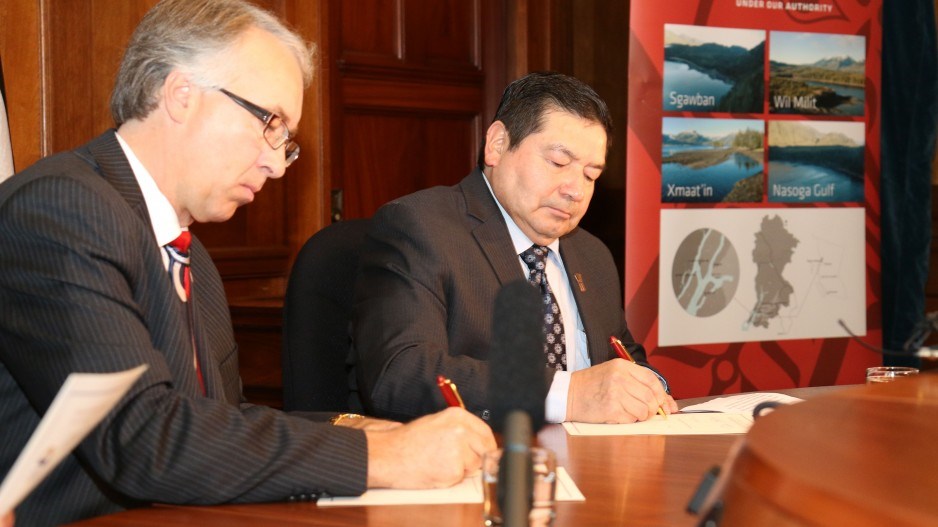B.C.’s fledgling liquefied natural gas (LNG) industry marked significant milestones last week with the environmental approval of two new gas pipelines and an agreement with the Nisga’a Lisims Government that will allow TransCanada Corp. (TSX:TRP) to build a new $5 billion gas pipeline through Nisga’a land.
TransCanada plans to build a 900-kilometre pipeline from Hudson’s Hope in northeast B.C. to Lelu Island near Prince Rupert for Petronas, the Malaysian state-owned petrochemical company behind the Pacific NorthWest LNG project.
That pipeline project as well as the Westcoast Connector pipeline, to be built by Spectra Energy (NYSE:SE ), have received B.C. environmental assessment certificates. Petronas’ Lelu Island LNG plant also received a certificate.
Both pipelines would convey natural gas to Prince Rupert and both would follow the same corridor when passing through Nisga’a land. To date, only the TransCanada pipeline project has reached a formal agreement with the B.C. government and the Nisga’a.
About one-ninth of the pipeline – 97 kilometres – cuts through land under the ownership or control of the Nisga’a, which in 1999 became the first B.C. First Nation to sign a modern-day treaty, granting the Nisga’a ownership over its own land, control over its own resources and powers of self-government, including taxation.
“Having the treaty has made this a lot more effective in accessing this opportunity,” Mitchell Stevens, president of the Nisga’a Lisims Government, told Business in Vancouver.
Stevens said the pipeline won’t just cut through Nisga’a land – his government is negotiating an agreement to gain access to some of the gas it will carry to develop its own LNG plants.
Nisga’a land has access to tidewater and four potential LNG sites have been identified, Stevens said. The plants would be small compared with the $11 billion LNG plant Petronas plans to build in Prince Rupert, but Stevens said they would provide continuing revenue and jobs for his people.
“We’re not interested in a pipe that comes from the northeast and goes to a point on the coast and bypassing us,” he said. “What we want is for ourselves to have our own facility where we could create a little bit of an industry so that our people could work.
“This is not just a four-year construction window. This must be an engine of opportunity where we begin to create our own economic base, which all ties back to the Nisga’a final agreement.”
The direct benefits from the pipeline will come from both the province and industry. Under a benefits agreement, the Nisga’a will receive $6 million from the B.C. government as the pipeline is built. It will also receive a share of the $10 million that will be paid annually to all First Nations along the pipeline route as part of a revenue-sharing agreement.
The projects are expected to boost employment among First Nations. To help ready them with the skills they will need, the B.C. government plans to invest $5.4 million in aboriginal skills training.
When the province and industry began talking about putting pipelines through Nisga’a land, Stevens said his government insisted that the pipelines to be built by TransCanada and Spectra Energy follow the same corridor, to minimize the environmental footprint.
That footprint includes cutting through a provincial park. About 64 hectares will have to be removed from the Nisga’a Memorial Lava Bed Provincial Park to make way for the pipelines. That’s a 0.38% reduction in the park’s size, Stevens said.
The pipelines will follow the existing corridor used for Highway 113 and a BC Hydro transmission line.
A total of three pipelines will need to be built to provide gas for some of the major LNG projects proposed. They pass through the territories of 30 B.C. First Nations.
In addition to the agreement with the Nisga’a, the B.C. government has reached agreements with 15 First Nations along the corridor of the Pacific Trail pipeline, which would serve Chevron Canada’s Kitimat LNG project. The agreement provides for $32 million in benefits to the 15 First Nations. The Haisla First Nation is a significant partner in the LNG projects proposed for Kitimat.
B.C. First Nations have been much more receptive to the gas and LNG industry than they have to crude oil pipelines.
Stevens said it’s not just the higher environmental risks associated with oil that have resulted in First Nations opposing oil pipeline projects but approving natural gas pipelines. He said the B.C. government and gas companies have done a much better job of consulting First Nations on the LNG file than the oil companies.
“The provincial government has done a lot of work consulting and so has the gas industry,” he said. “The oil industry has not done that work.”



